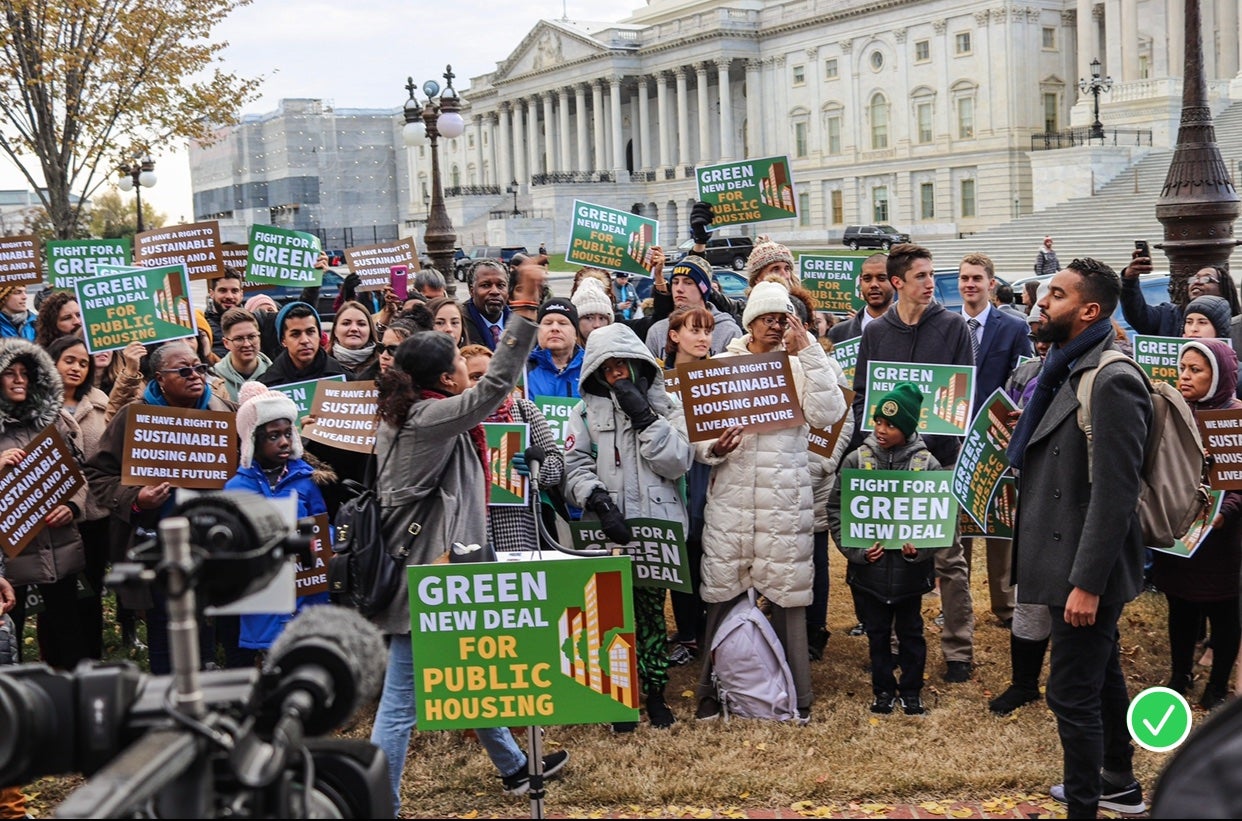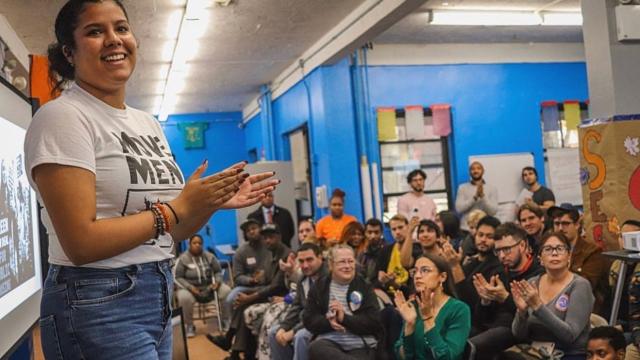For New York City-based organiser Ilona Duverge, housing justice isn’t just some theoretical concept. She knows what it’s like to be housing insecure firsthand.
“In 2017, I was living in the city, I was going to college at John Jay, and … I was couch surfing,” she said. “I mean, luckily, I have an incredible support system so I always had a couch to lay my head on at night. But yeah, there was a time in my life where I was living out of a backpack and didn’t have my own space.”
It was during her time at the John Jay College of Criminal Justice that Duverge decided to throw herself headfirst into the housing movement. She’d come to college to study law, but her classes — and the 2016 election of Donald Trump — left her feeling hopeless.
“I quickly learned that a lot of the systems that we built, a lot of the laws that exist, a lot of the rules of life in society, are complete bullshit,” she said. “I grew up undocumented and working class, and I realised these rules weren’t really for me.”
Rather than throwing up her hands, though, she began to think about how those systems could be fixed. Ultimately, the answer for her was that change would have to come from the bottom up, with ordinary people taking over the halls of power to create a world that worked for them.
“How do we change the laws? We change the faces of power,” she said. “And that’s when I saw I began to see electoral campaigns as a tool to build a movement to be able to achieve a livable future.”
The dangers of inadequate low-income housing crystallised in tragic fashion earlier this month when an apartment fire killed 17 in the Bronx. A space heater sparked a conflagration that quickly spread noxious smoke to every floor of the 19-story building. It’s a microcosm of the challenges that people relying on low-income or public housing face today. Lack of insulation, insufficient heating, and other issues tied to efficiency have left residents to turn to risky solutions from space heaters to using ovens to keep warm. In the summer, hot weather can be equally suffocating; many public housing developments and areas that were formerly redlined are even more intense heat islands than the surrounding areas due to the lack of trees and abundance of pavement.
These problems demand a wholesale change in how we think about housing in a changing climate. Duverge found a way to dive into pushing for those changes when her friend Randy Abreu launched a campaign to become the representative on the New York City Council for District 14 in the Bronx. She thought his vision was progressive and decided to get involved. Abreu was defeated by the more centrist incumbent candidate, but Duverge said everyone learned a lot from the experience — including her. Through her work with Abreu, she met Rep. Alexandria Ocasio-Cortez and went on to become a field organiser on her primary campaign before becoming her deputy organising director for the general election in 2018.
While working on Ocasio-Cortez’s campaign, Duverge began building Movement School, an organisation that hosts trainings for working class activists about how to run successful political campaigns. Ever the high-achiever, she was also still juggling school work, as well as an internship at the Centre for Court Innovation in the eastern Brooklyn community of Brownsville. There, she worked as a housing and legal fellow, working with tenants of the city’s public housing to help them advocate for themselves.

“I had family that lived in NYCHA, so I was familiar with NYCHA and I know how to move around in those communities,” she said of the New York City Housing Authority, which oversees the city’s public housing. Duverge built deep professional and personal relationships with her clients, putting in extra hours to help them and often going to their apartments for post-work dinner or conversations. She said feeling at home with her clients aided her success in helping them to keep their apartments.
Once Ocasio-Cortez won her general election in 2018, she began working with the Sunrise Movement to popularise the Green New Deal as a means to deal with the crippling and interlocking crises of climate and racial injustice. In her first year in Congress, Ocasio-Cortez introduced the Green New Deal as a resolution that would essentially be scaffolding for a suite of policies to decarbonize the U.S. and reshape society.
Duverge, who was no longer working for the congresswoman but maintained relationships with her and her staff, instantly gravitated toward the concept’s focus on democracy and environmental justice. But on the ground in New York City, working class people were talking about the importance of housing security much more than fighting climate change. Linking up the needs of New Yorkers fighting for fair housing and the Green New Deal preoccupied Duverge, but a Jacobin article by sociologist Daniel Aldana Cohen started to crystalize a way to do just that. Called “A Green New Deal for Housing,” the article laid out a proposal to build 10 million no-carbon public housing units over the next decade.
Crucially, the homes in Aldana Cohen’s plan wouldn’t just be livable, they’d also be beautiful. While public housing upgrades are needed across the country, New York could be among the most important test cases. It’s home to the largest number of units and modernising existing housing stock and building new apartments would have an outsize impact on bringing down the cost of zero-carbon technology.
“I started thinking, why can’t NYCHA be America’s first green city?” Duverge said. And it could actually benefit … and prioritise people of colour and working class people, which are the people that continuously get cut out of everything.”
Duverge ran the idea by Abreu, who was also working in Ocasio-Cortez’s office and overseeing the Green New Deal portfolio. She came armed with a solid understanding of how NYCHA operates and the challenges its residents face, including high energy bills, exposure to pollution, and difficulty understanding their rights.
“I just pitched the idea. And I was like, you know, we’re talking about getting a Green New Deal, but we actually have to start thinking about how we’re actually going to get there. This is a way we can get a great first step,” she said.
Abreu saw Duverge’s vision and took it directly to Ocasio-Cortez, who loved it and said it was worth writing up a federal bill. The congresswoman’s team brought on Aldana Cohen to help craft the policy. But getting residents’ input and buy-in was also essential, and Duverge played a key role in crafting the legislation by holding town hall meetings with public housing residents about what they’d want such a measure to do for them.
Aldana Cohen had worked on a proposal back in 2015 for a Green New Deal for NYCHA, which he said was a “total flop.” But with Duverge and others from Ocasio-Cortez’s team, he said, he saw an opportunity to make it a reality. Duverge introduced him to public housing tenants who were fellows with a Movement School housing justice program called Reclaim, and they ended up consulting on the plan. He was struck by how truly participatory the policymaking process was and how Duverge helped make it a reality. It was a total change from what he said was a process where normally “NGOs that are pretty well-funded are speaking on behalf of working class people of colour, and kind of intermediating between them.” Removing that barrier meant that the legislation could be more directly responsive to the needs of the people who would benefit from it.
In November 2019, Ocasio-Cortez formally introduced the Green New Deal for Housing on Capitol Hill along with Sen. Bernie Sanders, who sponsored it in the Senate. It was the first formal Green New Deal policy, and it sought to invest $US172 ($239) billion over 10 years in public housing upgrades, including updating wiring, electrifying appliances, installing renewable power on-site, plugging ventilation leaks, and more. It promised to improve living conditions for some 2 million people living in over 950,000 publicly owned units, while also creating jobs and averting carbon pollution.
The bill is the Platonic ideal of what a Green New Deal could look like. Climate and justice goals sit hand-in-hand. But more importantly, it’s built on input from the people it will impact, free from special interest influence, and written by a member of Congress from a working class background.
Yet two years later, the Green New Deal for Housing bill hasn’t gotten a hearing, let alone coming close to passing. But Duverge is still working to make it a reality. The fact that the legislation exists is also having an impact on policy conversations and organising on the ground.
In spring 2021, Duverge’s Movement School partnered with the Sunrise Movement to take the Reclaim fellowship national. In addition to offering a fellowship to another group of public housing tenants in New York, the organisations launched cohorts in Los Angeles, New Orleans, Miami, and San Juan, Puerto Rico. Each program works to help organise public housing tenants to fight for a Green New Deal for Public Housing. Duverge sees the fingerprints of this work all over the reconciliation bill that has received broad support from Democrats not named Joe Manchin. The proposal initially included $US80 ($111) billion in funding for public housing.
“The organising that we’ve been doing definitely had a big part in making sure that that happened,” she said. “That would never have even been on the table if it weren’t for our work, really.”
Those types of transformational investments will be absolutely critical in the coming years to both deal with the backlog of public housing repairs and prepare units for a future that is hotter, stormier, and fierier. The federal government has long deprioritized housing justice even as it pours money into agencies like the Department of Defence. The Green New Deal for Public Housing gives a sense of what would be possible, though, if those priorities shifted. The work Duverge has done to make the case and involve tenants is one avenue to bring that shift closer to reality.
“She’s someone for whom the climate-economy link is so intuitive as to be essentially unremarkable,” Aldana Cohen said. “The underlying premises of the Green New Deal are, to her, just common sense.”
